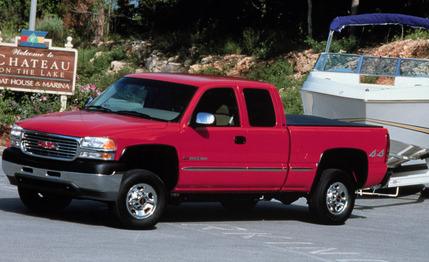
 First Drive Review
First Drive Review
A substantial slice of American male-dom is made up of draggers. Not dragsters but draggers, guys who quantify their cojones by the size of whatever they're hauling behind them. Horses, Harleys, Airstreams, super-modifieds, powerboats big enough to flatten the perfect storm. All of their toys travel in full, arrogant view.
To do it in style, they need to hook them not to just a pickup but a PICKUP. Certainly not one of the toy mini-trucks driven by contractors who haven't bought all their tools yet. Nor would they use one of the ordinary half-ton pickups with car engines, favored by newbies who figure they'll give this truck deal a shot.
No, what the bad boys need is one of the General's new three-quarter and one-ton heavy-duty dudes, totally redesigned and reengined for 2001 in hopes of taking the working-class market away from Ford. (Dodge's V-10 and Cummins-diesel-engined Rams are also players, but in third place.)
Although pickups are enormously profitable for their manufacturers -- largely because of economy-of-scale savings in their manufacture, since so many are sold -- they can also be thought of as superb values. GM's new HD line runs from $22,159 for a base Chevy Silverado rear-drive, two-door, short-bed 2500HD to $37,254 for a Chevy Silverado 3500 crew-cab four-wheel-drive with LT trim. Think of it as a bargain for a very powerful, big-V-8, luxurious four-door vehicle with capabilities no car could ever match.
The big GM news is its new engines, especially the diesel. Wait. Before you turn the page, be advised that this is a turbocharged, four-valve-per-cylinder, fractured-con-rod, nitrided-crank oil-burner that you could drive for a week and think was a big-block gas motor. It's a 300-hp, 6.6-liter V-8 diesel with 520 pound-feet of torque -- that's 63 more than a Lamborghini Diablo twists out -- and it rumbles like a polite Corvette. No smoke, no tack-tack-tack idle, no ball-peen hammers when you accelerate hard, excellent throttle response, and (we're told) easy starting in subzero weather.
Designed largely by Isuzu, a GM partner and one of the world's biggest manufacturers of diesels for everything from small cars to enormous ships, the new thumper owes its good manners largely to a common-rail fuel-delivery system. In a conventional diesel, fuel is metered, cylinder by cylinder, by the fuel pump, which, in the 6.5-liter predecessor to this engine, had a history of failures. With a common-rail system, a high-pressure pump keeps the rail -- a central pipe with feeds to each cylinder -- filled with fuel at 23,000 psi. (Yes, you read that right: 23,000 pounds per square inch.)
At each injector, a microprocessor-controlled valve precisely times and tailors the individual fuel pulses. And with 23,000 psi behind it, the fuel is metered and atomized so thoroughly that the combustion process is a refined event, not the conventional diesel's "okay, now I'll explode" hammer blow.
If you're looking for the ultimate in pure horsepower, you might prefer the newest in GM's 35-year line of big-blocks: the 340-hp, 8.1-liter Vortec V-8. That's 496 cubes, for those of you who still think in terms of its 396/454-cubic-inch "rat motor" direct predecessors, which makes it the baddest big-block gas engine in any production truck of any size.
Backing this range of engines is a choice of five- or six-speed manual and four- or five-speed automatic transmissions. The latter is a first for the class, chosen from the Allison catalog of big-rig trannies.
One thing hasn't changed. "Still rides like a truck," laughed the GM guy riding with me in a 6.0-liter gasoline-engined two-door 2500HD, the still-substantial bottom end of the range. Despite triple-stage rear leaf springs to absorb load in increments, there's no way (or, frankly, desire) to make an empty-bedded working pickup float like a car. Pavement-divider chop is somewhat muted, but there's still continual albeit slight hobbyhorsing.